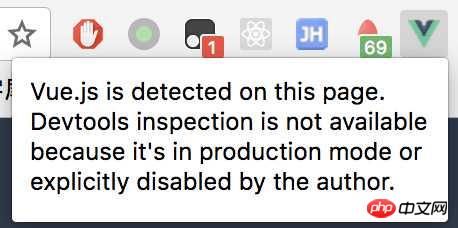这次给大家带来使用vue-admin-template优化步骤详解,使用vue-admin-template优化的注意事项有哪些,下面就是实战案例,一起来看一下。
前言
公司有好几个项目都有后台管理系统,为了方便开发,所以选择了 vue 中比较火的后台模板 作为基础模板进行开发。但是,开始用的时候,作者并没有对此进行优化,到项目上线的时候,才发现,打包出来的文件都十分之大,就一个 vendor 就有 770k 的体积(下图是基础模板,什么都没加打包后的文件信息):

通过 webpack-bundle-analyzer 进行分析可得,体积主要来源于饿了么UI(体积为 500k),因为没对其进行部分引入拆分组件,导致 webpack 把整个组件库都打包进去了。其次就是 vue 本身,体积也达到了 80k 之大。

所以,对其进行打包优化,是一件刻不容缓的事情。
优化
优化主要目的有:
加快资源加载速度,减少用户等待的时间和首页白屏时间,提高用户体验。
加快打包速度,不要将时间浪费在等待打包上。
解决第一个问题,很多人都会想到资源文件放在 CDN 上就好了,没错,这次我们就是通过 CDN 来解决加载问题。
CDN - 提高加载速度
像 vue, element ui 这些比较成熟的框架/组件库,一般都有免费、高速、公共的 cdn 供开发者使用,鉴于大部分用户均在国内,所以这次使用了 bootcdn 这个库。该库热门资源比较齐全,各个版本都有,而且国内访问速度很快,简直是开发者的福音。
在 index.html 中引入 vue 和 饿了么组件。
<!DOCTYPE html> <html> <head> <meta charset="utf-8"> <meta name="viewport" content="width=device-width,initial-scale=1.0"> <title>vue-admin-template</title> <!-- 同时也要引入对应版本的 css --> <link href="https://cdn.bootcss.com/element-ui/2.3.2/theme-chalk/index.css" rel="external nofollow" rel="stylesheet"> </head> <body> <p id="app"></p> <!-- built files will be auto injected --> <!-- 先引入 Vue --> <script src="https://cdn.bootcss.com/vue/2.4.2/vue.min.js"></script> <!-- 引入组件库 --> <script src="https://cdn.bootcss.com/element-ui/2.3.2/index.js"></script> <script src="https://cdn.bootcss.com/element-ui/2.3.2/locale/zh-CN.min.js"></script> </body> </html>
因为依赖是从外部引入的,所以需要告知 webpack 在打包时,依赖的来源。
修改 webpack.base.conf.js:
module.exports = {
...
externals: {
vue: 'Vue',
'element-ui':'ELEMENT'
}
}再一次打包,确实能极大的压缩了打包的体积,从 700k 骤减至 130k:

但是随之而来的就有问题了:

明明我在本地开发,但是由于引入了线上的生产版本的 vue 文件,因此 vue-dev-tools 就不能进行调试。
因此,我们需要再次调整一下 webpack 的配置,webpack.base.conf.js,而且 webpack 注入的 js 总是在最后面的,因此,我们需要 html-webpack-include-assets-plugin 帮忙在注入 app.js 后,再注入相对应的组件库 :
const HtmlWebpackIncludeAssetsPlugin = require('html-webpack-include-assets-plugin')
const externals = {
// 因为打包时,还没注入,所以这里要去掉。
// 'element-ui':'ELEMENT'
}
// 生产环境中使用生产环境的 vue
// 开发环境继续使用本地 node_modules 中的 vue
if (process.env.NODE_ENV === 'production') {
externals['vue'] = 'Vue'
// 如发现打包时依旧将 element-ui 打包进入 vendor,可以在打包时将其加入外部依赖。
externals['element-ui'] = 'ELEMENT'
}
// 生产环境默认注入 vue
// 开发环境中不注入
const defaultJS = process.env.NODE_ENV === 'production' ? [{ path: 'https://cdn.bootcss.com/vue/2.4.2/vue.min.js', type: 'js' }] : []
const plugins = [
new HtmlWebpackIncludeAssetsPlugin({
assets: defaultJS.concat([
{ path: 'https://cdn.bootcss.com/element-ui/2.3.2/index.js', type: 'js' },
{ path: 'https://cdn.bootcss.com/element-ui/2.3.2/locale/zh-CN.min.js', type: 'js' },
]),
// 是否在 webpack 注入的 js 文件后新增?true 为 append, false 为 prepend。
// 生产环境中,这些 js 应该先加载。
append: process.env.NODE_ENV !== 'production',
publicPath: '',
})
]
module.exports = {
...
externals,
plugins,
...
}OK,这时候,既能兼顾打包后的体积大小,也能在开发模式中使用 vue-dev-tool 进行调试。
DLL - 提高打包速度
经常打包的前端会发现,很多时候,我们为了修复某些bug(如 promise 在 ie Safari 下的 bug),而新引入了一个 polyfill,然而,打包完后发现,vendor 的 hash 值变了,而整个 vendor 只新加了一个 es6-promise 的依赖,但是付出的代价就是,需要抛弃之前打包好的 vendor,用户重新访问时,需要再一次拉取一个全新的 vendor,这个代价就有点大了。
这时候,使用 dllPlugin 打包就有优势了。它可以将一些基础依赖模块统一先打包起来,当正式打包时,则可以略过这些模块,不再重复打包进去 vendor,提高打包速度的同时也能减少 vendor 的体积。
如,后台管理系统基础模块基本有以下几个:
axios: ajax 请求。
vuex: 全局状态管理。
js-cookie: 前端处理 cookie
vue-router: 路由管理。
这四个基础模块几乎是必须的,那么可以先提取出来。
step 1 打包基础模块
先在 build 文件夹下新建一个用于打包 dll 的配置文件 webpack.dll.conf.js:
const webpack = require('webpack');
const path = require('path');
const vueLoaderConfig = require('./vue-loader.conf')
const utils = require('./utils')
function resolve(dir) {
return path.join(dirname, '..', dir)
}
const vendor = [
// 'vue/dist/vue.runtime.esm.js', // 由于 vue 在生产环境中使用的是 cdn 引入,所以也无需提前打包进 dll
// 'raven-js', // 前端监控,若无此需求,可以忽略。
'es6-promise', // 修复 promise 中某些 bug。
'vue-router',
'js-cookie',
'axios',
'vuex',
];
const webpackConfig = {
context: dirname,
output: {
path: path.join(dirname, '../static/js/'),
filename: '[name].dll.js',
library: '[name]_[hash]',
},
entry: {
vendor
},
plugins: [
new webpack.DllPlugin({
context: dirname,
path: path.join(dirname, '.', '[name]-manifest.json'),
name: '[name]_[hash]',
}),
new webpack.optimize.UglifyJsPlugin({
compress: {
warnings: false
},
sourceMap: true,
// parallel: true
})
],
module: {
rules: [{
test: /\.vue$/,
loader: 'vue-loader',
options: vueLoaderConfig
},
{
test: /\.js$/,
loader: 'babel-loader',
include: [resolve('src'), resolve('test'), resolve('node_modules/webpack-dev-server/client')]
},
{
test: /\.(png|jpe?g|gif|svg)(\?.*)?$/,
loader: 'url-loader',
options: {
limit: 10000,
name: utils.assetsPath('img/[name].[hash:7].[ext]')
}
},
{
test: /\.(mp4|webm|ogg|mp3|wav|flac|aac)(\?.*)?$/,
loader: 'url-loader',
options: {
limit: 10000,
name: utils.assetsPath('media/[name].[hash:7].[ext]')
}
},
{
test: /\.(woff2?|eot|ttf|otf)(\?.*)?$/,
loader: 'url-loader',
options: {
limit: 10000,
name: utils.assetsPath('fonts/[name].[hash:7].[ext]')
}
}
]
}
};
module.exports = webpackConfig然后在 package.json 中加入一条命令:
{
"scripts": {
...
"build:dll": "webpack --config build/webpack.dll.conf.js",
...
}
}执行 yarn build:dll 或者 npm run build:dll 即可完成打包 dll。执行完成后:
yarn build:dll
yarn run v1.5.1
$ webpack --config build/webpack.dll.conf.js
Hash: f6894dff019b2e0734af
Version: webpack 3.10.0
Time: 1295ms
Asset Size Chunks Chunk Names
vendor.dll.js 62.6 kB 0 [emitted] vendor
[8] dll vendor 12 bytes {0} [built]
+ 32 hidden modules
✨ Done in 1.89s.同时,可以在 build 目录下,找到各个模块对应关系文件 vendors-manifest.json 和 static/js 下的 vendor.dll.js。
step 2 页面中引入 vendor
打包后的 dll 文件需要手动在 index.html 引入:
<p id="app"></p> <!-- built files will be auto injected --> <script src="static/js/vendors.dll.js"></script>
step 3 告诉 webpack 使用 dllPlugin 进行打包
修改 build/webpack.prod.conf.js:
module.exports = {
plugins: [
...
new webpack.DllReferencePlugin({
context: dirname,
manifest: require('./vendor-manifest.json')
}),
...
]
}再次打包:
$ yarn build:report
yarn run v1.5.1
$ npm_config_report=true node build/build.js
Hash: b4ff51852866ed865cfd
Version: webpack 3.10.0
Time: 6532ms
Asset Size Chunks Chunk Names
static/js/manifest.42b9584a653aec2b9c5e.js 1.5 kB 5 [emitted] manifest
static/img/404.a57b6f3.png 98.1 kB [emitted]
static/js/1.9e4133a25808e2101dd3.js 1 kB 1 [emitted]
static/js/2.2a8a8e01c51473fab882.js 4.34 kB 2 [emitted]
static/js/vendor.c7b076ef3341d4711402.js 39.4 kB 3 [emitted] vendor
static/js/app.6d52c7a5bf1bacb5cc85.js 21.4 kB 4 [emitted] app
static/js/0.cbc645864aab28ae8055.js 15.3 kB 0 [emitted]
static/css/app.1b30f8eba210e245a5f96d7bf0d6fb6c.css 7.6 kB 4 [emitted] app
favicon.ico 67.6 kB [emitted]
index.html 986 bytes [emitted]
static/js/vendor.dll.js 62.6 kB [emitted]
Build complete.
Tip: built files are meant to be served over an HTTP server.
Opening index.html over file:// won't work.发现 vendor 现在只有 40k 的体积,减少了一半的体积,而且打包速度也快了 2s,而相对于最开始的基础模板,打包速度快了 12s,这是很让人欣慰。
相信看了本文案例你已经掌握了方法,更多精彩请关注php中文网其它相关文章!
推荐阅读:
如何使用v-model与promise两种方式实现vue弹窗组件
怎样使用Vue+Jwt+SpringBoot+Ldap完成登录认证
以上就是使用vue-admin-template优化步骤详解的详细内容,更多请关注php中文网其它相关文章!

每个人都需要一台速度更快、更稳定的 PC。随着时间的推移,垃圾文件、旧注册表数据和不必要的后台进程会占用资源并降低性能。幸运的是,许多工具可以让 Windows 保持平稳运行。

Copyright 2014-2025 https://www.php.cn/ All Rights Reserved | php.cn | 湘ICP备2023035733号